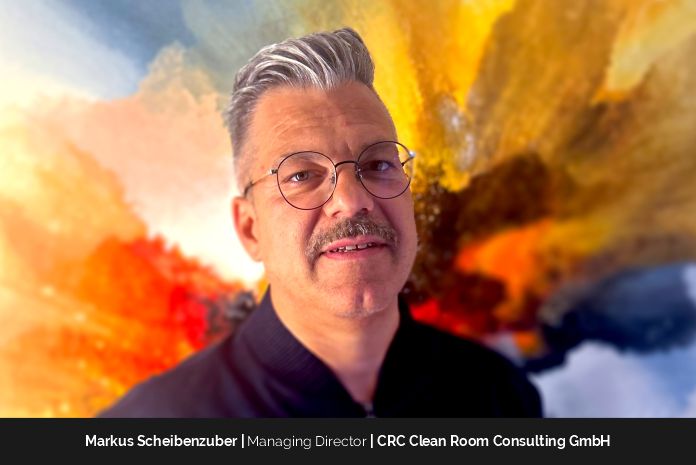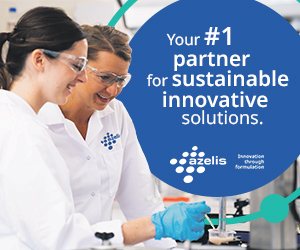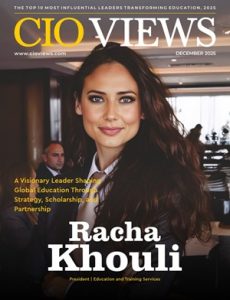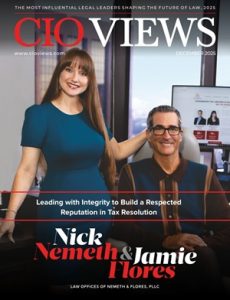Introduction
Markus Scheibenzuber, Managing Director and Stakeholder at CRC Clean Room Consulting GmbH, is an experienced leader in cleanroom engineering, process engineering and building technology for various high-tech industries like Semiconductor and Pharma. Earlier in his career, he worked as a turnaround advisor at Schultze & Braun focusing on company restructuring and distressed M&A and as a banking analyst at American Express. He holds a BBA degree from TU Chemnitz and a MBA from Goethe University Frankfurt/Main.
With a solid background in strategy, operations, and technology, Markus has consistently made an impact by aligning business objectives with cutting-edge solutions that create long-term value. His ability to bridge the gap between technology and business performance, combined with his commitment to digital transformation, operational efficiency, and customer-centric innovation, strengthens his reputation in the industries he works for.
Journey from Finance to High-Tech Engineering
Engaging in a conversation with Markus Scheibenzuber, he spoke about his career journey, transitioning from finance to high-tech engineering.
Markus stated that even during his academic years his interests and strengths were firmly rooted in business management, markets, industries, and technologies. Success in these areas is often tangible and measurable, whether in sales, leadership, building partnerships, or setting strategic direction.
Joining CRC was not part of his predetermined career plan, although he had been familiar with the company from a young age, as his father was one of its founders in 1983.
When the opportunity arose in 2009, he embraced it. What drew him in was CRC’s immense potential, the combination of highly skilled engineers, a market with significant growth prospects, and a clear focus on cutting-edge technology. The true turning point came when he was able to connect his commercial expertise with a high-tech environment. The bridge was not only the technology itself, but the entrepreneurial responsibility it demanded: driving sales, leading teams, shaping strategy, and developing partnerships.
CRC is a One Stop Shop Solution
Markus quickly recognized the potential to expand CRC around its core strength in high-tech engineering. The company already had extensive expertise in designing pharmaceutical production and research buildings as well as semiconductor fabs. The next step was to increase CRC’s visibility with clients and to ensure the company was not reliant on just a few key leaders. It was essential to broaden the organisation and establish a structure that could sustain growth independently while delivering exceptional value to its clients.
The company’s great strength lies in its specialisation in high-tech facilities. They offer their clients a true one-stop shop, providing the full spectrum of highly specialised design services required for the construction of these advanced production buildings, all from a single source.
Over the years, Markus has experienced first-hand how building design has undergone transformative changes. Most notably, digitalization and Building Information Modeling (BIM) have transformed the entire approach to facility design. The use of 3D digital twins allows the integration of all technical trades from HVAC systems to process piping into a single model. As a result, potential clashes can be resolved early and detailed airflow as well as energy analyses can be conducted before construction even begins.
Another major shift is the rise of fast-track projects. In high-tech industries, time-to-market is critical. Modular planning and prefabricated components have significantly shortened project timelines, creating a decisive competitive advantage for CRC’s customers.
Simultaneously, the importance of regulatory compliance and global standardization has continued to grow. Operating in highly regulated industries such as pharmaceuticals and semiconductors requires strict adherence to international guidelines, as the building and cleanroom design must fully incorporate compliance requirements from the earliest design phases.
Equally critical is the focus on energy efficiency and sustainability. Given the high energy demand of cleanrooms, innovations in energy management, air handling systems and sustainable building concepts are essential to reducing operating expenses as well as the ecological footprint. Finally, the integration of automation and robotics is fundamentally reshaping the cleanroom environment. Automated systems transform personnel and material flows and place new demands on buildings and technical infrastructure. These aspects must be taken into account right from the very beginning of the design process.
In combination, these trends are driving a new era in cleanroom design, resulting in smarter, faster-to-construct, more sustainable facilities that meet the future needs of high-tech industries.
Clarity, Focus, and Discipline
Markus’s leadership approach is built on three core principles. Clarity and transparency come first as large-scale projects require all stakeholders to have a clear understanding of objectives, responsibilities, and timelines. Second, he focuses on empowerment and trust. Complex projects can only succeed when highly skilled teams are given the autonomy to apply their expertise while knowing leadership is there to support and remove obstacles. Finally, discipline in execution is crucial. With multi-million-dollar facilities, precision in design, cost control, and risk management are essential to deliver on time, on budget and to the highest quality standards.
Given CRC’s international operations, Markus outlined the strategies they have implemented to expand their specialized engineering services across multiple markets. Scaling such specialised service internationally requires a careful balance between standardization and localization. The company’s core methodologies, i.e. EPCM processes, quality standards, and project controls, are applied consistently worldwide, while each market has its own regulatory requirements, cultural expectations, and business practices
Their strategy has been to build strong local partnerships in each region, combining their expertise with local knowledge. They also invest heavily in talent development, hiring engineers and project managers who are not only technically skilled but also culturally adaptable.
Finally, CRC maintains a globally connected leadership team. Their engineers in Germany collaborate seamlessly with colleagues in Europe, India, the US, or Asia, leveraging digital tools that allow them to operate as a unified organization across borders.
High Standards and Precision
Commenting on how they maintain consistently high standards across all their projects in an industry where precision is critical, Markus explained that, fundamentally, it is important to use the experience gained from many projects as a foundation. Each project is unique, but the extensive knowledge gained from a wide range of past projects is of outstanding importance, and their teams bring this extensive expertise. Employee retention, ongoing training, and adherence to unified rules and standards play a critical role. By taking responsibility, relying on proven solutions, and continuously considering innovative approaches, their experienced and highly specialized teams deliver consistent results.
Consistency is achieved both from process discipline and company culture. On the process side, they have developed rigorous quality management systems that govern every project phase. From early design to commissioning, the team implements checkpoints, peer reviews, and digital validation tools to ensure thoroughness. On the cultural side, they cultivate a mindset of precision within their teams. Cleanroom engineering is not forgiving. Even a 1% mistake can lead to total project failure, which is why they hire individuals who embrace this responsibility and strive for flawless results.
Collective Judgment for Critical Decisions
When making critical decisions on highly technical projects, Markus follows four principles: prioritizing data to understand the facts, expert input from engineers and stakeholders, scenario analysis to evaluate best and worst-case outcomes, and taking timely action, since delays can be as harmful as mistakes.
Ultimately, decisions are made together with the management team because collective judgment is stronger and ensures alignment across the organization.
Building Lasting Partnerships Through Trust
Delineating on how CRC builds trust with their clients investing in high-stakes facilities like wafer fabs and pharma production plants, Markus described that trust is earned through transparency and performance.
Transparency about risks, challenges, and costs is central to their client relationships, as sugar coating reality would only lead to disappointment. At the same time, they consistently deliver on their commitments. Over the years, this has built long-term relationships with clients who know CRC will always prioritize their interests. In fact, many of their new projects come from repeat clients, which they see as the highest compliment.
Furthermore, explaining how he manages to keep pace with rapidly evolving technologies in semiconductor and pharma manufacturing, Markus explained that he stays informed through ongoing dialogue with teams, clients, and partners, both in person and virtually. Additionally, he regularly leverages LinkedIn and industry podcasts to gain insights and track emerging trends. However, the most valuable learning often comes directly from the projects themselves. Each facility they design pushes the boundaries of what’s possible, and they integrate those lessons into their next project.
Balancing Personal and Professional life
Balancing running an international engineering company with personal life is always a challenge. For Markus it starts with finding joy in his work. He places great trust in his teams and gladly gives them responsibility, which allows him to step back at times and consciously create space for himself. In his leisure, he draws strength from being with his wife and children. Whether they are travelling around the world, playing sports, or simply relaxing together.
Guiding Principles for Entering the High-Tech Facility Market
When advising other business leaders seeking to enter the high-tech facility engineering market, Markus has four major strategies to share.
The first is to truly understand the industries you serve. High-tech facilities are not just technical buildings; rather, they are mission-critical infrastructures for sectors such as semiconductors, biotech, and pharmaceuticals. To succeed, one needs to deeply grasp the drivers, constraints, and regulatory frameworks of these industries.
Second, invest heavily in talent and specialization. This market leaves no space for generalists. Clients demand world-class expertise in every technical discipline, from cleanroom technology and process systems to digital integration and sustainability.
Third, be patient and build trust. Credibility in this field cannot be bought; it must be earned over years of flawless execution and long-term partnerships.
The fourth strategy is to think globally, act locally. High-tech engineering is an international business, but projects are executed on the ground. The ability to combine global know-how with strong local execution capabilities makes all the difference.
Shaping the Future of Cleanroom Technology
Sharing his perspective on the future of cleanroom technology and CRC’s strategic positioning, Markus stated that technological advancements are placing higher demands on building systems. At the same time it’s important to focus on investment and lifecycle costs. Their clients require optimal production conditions delivered through future-proof and flexible facility and system designs, while keeping both capital expenditure and operating costs as low as possible. Ultimately, the primary goal of any factory is to generate strong ROI, and this principle guides all of CRC’s activities.
Looking ahead, he sees three major trends shaping the cleanroom industry. First, AI-driven facility design and operation as predictive modelling will optimise airflow, contamination control, and energy efficiency in real time.
Second, sustainability will be the baseline requirement as clients will increasingly demand carbon-neutral cleanroom buildings. With their deep technical expertise and strong entrepreneurial drive to advance in this area, they are already on a very promising path to meet these expectations.
Third, global capacity expansion as demand for high-tech facilities remains strong, with new markets emerging in regions like Thailand and Vietnam, and new industries requiring clean room buildings. At CRC, they aim to partner closely with their clients and partners to support their global expansion and address evolving needs.
Building Legacy
Discussing the development of future leaders within CRC and the broader industry, Markus explained that the company focuses on giving young engineers early responsibility, supported by mentoring and training. They encourage them to lead projects, make decisions, and learn from both successes and failures.
To prepare future leaders more systematically, they have established a structured approach for both technical and leadership development. This allows them to nurture specialists as well as emerging leaders. For progression into the Management Board, they rely on a steering committee, which serves both as a sparring partner for the Board and as a platform for further development and career advancement.
Explaining what drives Markus personally in this highly technical and demanding industry, he asserts it’s the opportunity to shape the future through technology. He is fascinated by looking ahead, recognising new possibilities, and helping to develop solutions that will have a lasting impact.
Beyond his role at CRC, Markus is also active as a business angel investor in start-ups, particularly in the deep-tech sector. He finds inspiration in collaborating with founders who share his passion and vision for the future, pushing technological boundaries.
At CRC, his primary motivation lies in the impact of their work. Every facility they design enables technologies that shape the world around us, whether it’s advancing the next generation of microchips or supporting the development of life-saving pharmaceuticals.





